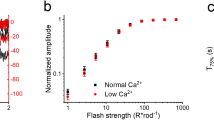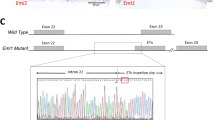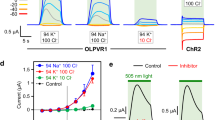Abstract
THE involvement of calcium in the transduction process in vertebrate photoreceptors, in particular rods, has been postulated by Yoshikami and Hagins1, who suggest that this cation is sequestered in the membranous disks of the outer segment and released on stimulation by light. Recently, evidence supporting this hypothesis was obtained by Fishman et al.2 who, using an electron microscopic technique3–5 for the localisation of calcium, showed precipitate within the disks of frog rod outer segments. However, they did not explore the possibility of a light-induced decrease of calcium within the disks, which would have further supported the hypothesis. We report here evidence for the involvement of calcium in the phototransduction process in a unique vertebrate photoreceptive system.
This is a preview of subscription content, access via your institution
Access options
Subscribe to this journal
Receive 51 print issues and online access
$199.00 per year
only $3.90 per issue
Buy this article
- Purchase on Springer Link
- Instant access to full article PDF
Prices may be subject to local taxes which are calculated during checkout
Similar content being viewed by others
References
Yoshikami, S. & Hagins, W. A. in Biochemistry and Physiology of Visual Pigments (ed. Langer, H.) 245–255 (Springer, New York, 1973).
Fishman, M. L., Oberc, M. A., Hess, H. H. & Engel, W. K. Expl Eye Res. 24, 341–353 (1977).
Simson, J. A. V. & Spicer, S. S. J. Histochem. Cytochem. 23, 575–598 (1975).
Debbas, G., Hoffman, L., Landon, E. J. & Hurwitz, L. Anat. Rec. 182, 447–472 (1975).
Schechter, J. E. Am. J. Anat. 146, 189–206 (1976).
Brown-Séquard, E. C. r. hebd. Séanc. Paris Acad. Sci., 25, 482 (1847); J. Physiol., Lond. 2, 281–294 (1859); J. Physiol., Lond. 2, 451–460 (1859).
Steinach, E. Pflügers Arch. ges. Physiol. 52, 495 (1892).
van Herk, A. W. A. Archs néerl. Physiol. 13, 534–568 (1928).
Bell, A. L. thesis, New York State Univ. (1967).
Barr, L. & Alpern, M. J. gen. Physiol. 46, 1249–1265 (1963).
Glaus-Most, L. Revue suisse Zool. 76, 799–848 (1969).
Bito, L. Z. & Turansky, D. G. Comp. Biochem. Physiol. 50 A, 407–413 (1975).
Spurr, A. R. J. Ultrastruct. Res. 26, 31–43 (1969).
Martell, A. E. & Sillen, L. G. (eds) in Stability Constants of Metal-Ion Complexes 697–698 (Chemical Society, London, 1964).
Nakas, M., Higashino, S. & Loewenstein, W. R. Science 151, 89–91 (1966).
Mann, I. in The Development of the Human Eye Ch. 4 (Butler and Tanner, London, 1964).
Blaustein, D. I. & Dewey, M. M. J. gen. Physiol. 70, 2a (1977).
Author information
Authors and Affiliations
Rights and permissions
About this article
Cite this article
ZUCKER, R., NOLTE, J. Light-induced calcium release in a photosensitive vertebrate smooth muscle. Nature 274, 78–80 (1978). https://doi.org/10.1038/274078a0
Published:
Issue Date:
DOI: https://doi.org/10.1038/274078a0
This article is cited by
Comments
By submitting a comment you agree to abide by our Terms and Community Guidelines. If you find something abusive or that does not comply with our terms or guidelines please flag it as inappropriate.



